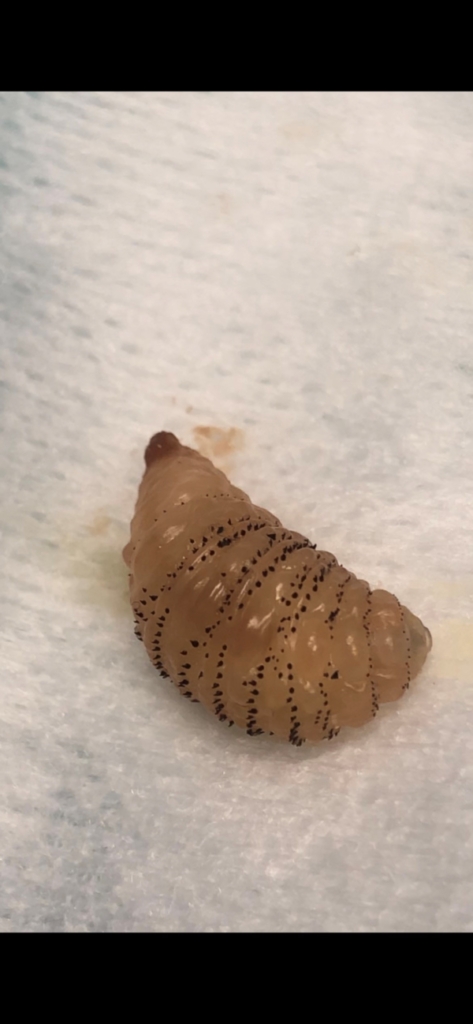HISTORY:
A 50+ year old female presents to the office with a draining “cystic” lesion on left inner thigh ongoing for 2 months. Her PCP treated with Ciprofloxacin for 7 days, followed by Bactrim DS for 10 days with no improvement. The patient reports the lesion appeared after a trip to Belize and has gradually gotten bigger since. She also reports minimal drainage, mild tenderness with palpation, itching and reports of occasional “sharp, shooting pain.”
Question: What is the likely cause of this lesion?
ANSWER:
Cutaneous myiasis (Botfly larva)

SUMMARY:
Myiasis is an infestation of human tissue by larvae. In this case specifically, bot fly larvae. This is commonly seen in tropical or subtropical regions, or in patients who have recently traveled to these regions. The adult female egg can enter the skin through an insect bite (most commonly tick or mosquito) or will penetrate the skin once in contact with the host. Prevention for myiasis is aimed at avoiding insect bites by wearing protective clothing and use of insect repellents (Chen et al, 2018).
Patients will typically present with complaints of a non-healing lesion that they believe to be an insect bite or cyst. Treatment is aimed at removal of the larvae and preventing/treating any subsequent bacterial infection. Ensuring that the entire larvae is removed is important; a foreign body or granulomatous reaction may occur if there are remnants of the larvae left within the cavity. The larvae has spiny projections which can make extrusion of the larvae difficult and increase the risk of incomplete removal. Surgical debridement with local anesthesia is curative, but also increases risk of partial removal, thus increasing risk of foreign body reaction. Occlusion of the punctum will cause the aerobic larvae to surface for air (typically after a few hours), at which point extraction with forceps may be successful. Occlusion can be accomplished by covering the punctum with substances such as petroleum jelly or nail polish. Occlusion with bacon (called “bacon therapy”) may coax the larvae out of the punctum. Additionally, lidocaine may be injected into the cavity inhabited by the larvae, thus forcing the larvae to the surface Bolognia et al, 2012).
In this particular case, after discussing various treatment options with the patient, it was decided to proceed with occlusion of the punctum as in “bacon therapy.” As an alternative to bacon, we instructed patient to cover punctum with Arby’s roast beef sandwich (a clinical pearl learned in my collaborating physician’s residency) for a few hours and return in the afternoon for reassessment with the hopes that the larvae would be coaxed out. She came back to office approximately 4 hours later, the larvae was protruding approximately halfway out of the skin and we were able to successfully remove the botfly larvae with forceps. The patient called a few hours later to let us know she was already “feeling much better!”
FOLLOW-UP:
Signs and symptoms of secondary bacterial infection were reviewed. Patient instructed to follow up in 1 month for assessment or sooner if worsening/non-healing.
By: Dr. Ashley Dietrich, Amy Thayer, FNP-C
References:
Bolognia, J., Jorizzo, J., Schaffer, J. (2021). Dermatology. (pp.1432-1433) Elsevier.
Chen, M., Phelps, R. (2018). Myiasis. In M. Lebwohl, J. Berth-Jones, W. Heymann, I. Coulson (Eds), Treatment of skin disease. (pp. 538) Elsevier.